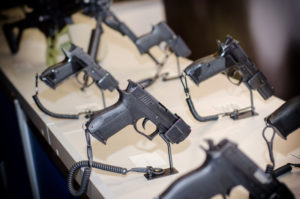
Scholars discuss whether current regulations can effectively control 3D-printed guns.
Ever since the first 3D-printed gun successfully fired a .380 caliber bullet in 2013, policymakers have debated how best to regulate this new technology.
3D printing—a manufacturing process that creates three-dimensional models by reading a digital file and building the desired physical object—has demonstrated substantial societal benefits. During the COVID-19 pandemic, for example, hospitals have used 3D printers to produce protective medical gear quickly and cheaply. Regulators, however, have flagged 3D-printed weapons as a potential concern.
3D-printed firearms—also known as “ghost guns”—pose unique threats to public safety, according to law enforcement agents. For instance, 3D printing allows individuals to procure a weapon by printing it at home even if they would not pass a background check. In addition, unlike firearms produced using traditional methods, a 3D-printed plastic gun may be difficult to track and could avoid setting off metal detectors, circumventing the federal Undetectable Firearms Act.
Although any discussion of gun regulations implicates the U.S. Constitution’s Second Amendment, most arguments supporting access to 3D-printed guns do so on First Amendment grounds. As Harvard Law School’s Noah Feldman explains, “the government could almost certainly prohibit unregulated home manufacture of guns” and not run afoul of the Second Amendment. The First Amendment, however, likely protects computer code that directs a 3D printer as free speech.
Even though U.S. President Donald J. Trump stated in 2018 that “3D plastic guns being sold to the public … doesn’t seem to make much sense,” his Administration has largely stepped back from regulating 3D-printed firearms. In response, states have urged the federal government to adopt more stringent regulations across different agencies, including the U.S. Bureau of Alcohol, Tobacco, Firearms and Explosives.
States are also taking measures to regulate 3D-printed firearms within their own borders. California was the first state to enact a “ghost gun” law, mandating that these weapons have a unique serial number imprinted on an attached piece of stainless steel and only be assembled by individuals who are eligible to possess a gun in the state. New Jersey, which has similar restrictions, also criminalizes distributing instructions on how to manufacture 3D-printed firearms. These laws, however, may “prove difficult to enforce unless authorities catch someone with an untraceable, undetectable, or unregistered 3D-printed gun.”
This week’s Saturday Seminar outlines current battles over 3D-printed firearms and potential regulatory approaches to this new technology.
- In a recent article in Law and Contemporary Problems, Josh Blackman of the South Texas College of Law Houston details his years-long battle advocating the right to distribute design schematics for 3D-printed guns. Blackman, the attorney for Cody Wilson, creator of the first 3D-printed gun, describes the “twists and turns” of years of litigation—involving the Obama Administration, the Trump Administration, and various state attorneys general—over whether these design files can be posted online. Because “the First Amendment protects data,” Blackman argues, the design files used by 3D printers to create firearms fall under lawful speech. This constitutional protection exists, Blackman writes, “even if the objects depicted on screen are firearm parts, and those files could be used to engage in criminal conduct.”
- In District of Columbia v. Heller, the U.S. Supreme Court held that the Second Amendment protects an individual’s right to have certain types of weapons that are “in common use” by law-abiding citizens, as opposed to “unusual” weapons. In an article in the Maryland Bar Journal, attorney Elizabeth A. Harlan considers whether courts applying the common use test to 3D-printed guns should examine the weapons’ manufacturing process or their individual characteristics. Harlan concludes that the current test established in Heller is inadequate to evaluate bans or regulations on 3D-printed guns, because of the near impossibility of demonstrating “when these weapons achieve common use” under either metric. But because commonly used weapons merit Second Amendment protection, Harlan argues that efforts to regulate or ban 3D-printed guns must proceed now, before these guns become commonly used.
- In an article published in the Minnesota Journal of Law, Science and Technology, Adam D. Thierer and Adam Marcus of George Mason University suggest a “permissionless innovation” policy for regulating 3D printing. This approach would attach few restrictions in advance to 3D printing and address problems that derive from people wrongly using 3D-printed guns in an ex post fashion, permitting developers to explore the full potential of the technology. A regulatory approach that responds to fear and potential worst-case scenarios instead of individual problems as they arise, Thierer and Marcus argue, could hinder crucial growth in this new space. Under this “permissionless innovation” framework, they note, regulations on 3D-printed guns should focus “on the user and uses of firearms, regardless of how they are manufactured.”
- 3D-printing technology could boost organized crime, intellectual property theft, and sabotage in the United States, Jonathan Percy of GXM Consulting claims. In an article in Homeland Security Affairs, Percy discusses how 3D-printed guns could negatively impact national security because these weapons “are unlikely to be caught using traditional investigative methods” such as border checkpoints. Despite scarce evidence of terrorists using 3D technology for illegal activity, he argues that national security and law enforcement authorities should not simply wait for these issues to come to fruition before addressing them. Percy urges lawmakers to explore technical solutions as well as direct the U.S. Bureau of Alcohol, Tobacco, Firearms and Explosives to implement a registration process for 3D-printed guns.
- First Amendment questions about restricting schematics for 3D-printed guns can be avoided by using copyright law, R Street Institute’s Charles Duan argues in Lawfare. Because the plastic gun digital schematic receives a copyright, he posits that the government could take ownership of that copyright under the Fifth Amendment’s Takings Clause, which allows the government to exercise its sovereign right to acquire private property for the public interest. Duan outlines a scheme where the government, or a nonprofit organization to which the government transfers the copyright, could then sue the creator of the 3D-printer gun schematics to prevent them from distributing their own design. “Whether or not the government can stop distribution of the schematic directly, it likely can do so using copyright without violating the First Amendment,” he claims. Duan cautions against this approach, however, acknowledging a government could turn copyright into a “general-purpose censorship tool.”
- Regulations governing the traditional processes of manufacturing guns, or gunsmithing, are ill-suited to manage 3D printers, New York University School of Law’s James B. Jacobs and Winston and Strawn’s Alex Haberman argue. In an article published in Law and Contemporary Problems, Jacobs and Haberman point to four existing regulations that limit traditional gunsmithing but may be less effective at governing 3D-printer gunsmithing: metal detectors that control where one can carry a gun, background checks that restrict who can purchase a gun, serial numbers that trace a “gun’s first purchaser,” and laws that ban automatic-fire weapons. 3D-printer gunsmithing could undermine these restrictions by giving “firearms-ineligible individuals” the ability to make a gun at home, for example. Considering these regulatory shortcomings, Jacobs and Haberman advocate experimenting “with new regulatory controls” before 3D-printer gunsmithing simplifies and decentralizes gun manufacturing.
The Saturday Seminar is a weekly feature that aims to put into written form the kind of content that would be conveyed in a live seminar involving regulatory experts. Each week, The Regulatory Review publishes a brief overview of a selected regulatory topic and then distills recent research and scholarly writing on that topic.



